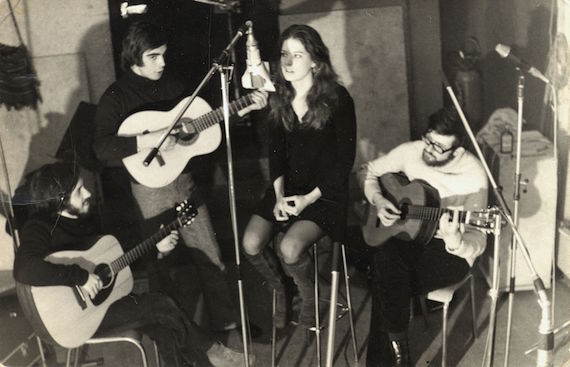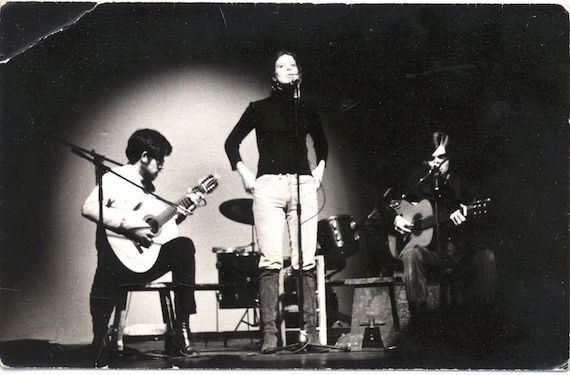Back Ground of I Wish I Were a Single Girl Again

Christiana Wallman passed abroad in June in Pinehurst, North Carolina, at the age of 63. Those who know about the album she recorded nether the name Tia Blake accept long puzzled over her backstory, which in some ways, is just as hazy and enigmatic equally the music she made. Here are some devious details: she was born in Georgia to a father who may have been a CIA agent and a mother, Joan Blake, who would become on to establish the Canadiana landmark that was Double Hook Bookstore in Montreal. She herself spent well-nigh of her life equally a writer (article in Granta, play at the New York Fringe Festival), but very briefly, she refashioned herself a folk chanteuse in Paris. It was there, circa 1970, that she fell in with a group of musicians and cutting an LP of folk standards for a modest and unglamorous-sounding French label,Société Française de ProductPhonographiques. Such was the scale of the production, in fact, that a number of copies were misattributed to 'Tia Blake and His Folk-Group' despite Blake's cute visage appearing on the album cover. There followed a lone gig at the famedThéî¢tre du Vieux-Colombier, so a relocation to Montreal, then a few tracks (never used) laid down in a CBC studio–and that was all, the end of Tia Blake every bit a recording artist.
However, Folksongs & Ballads, despite its throwaway title and the transparent objective (pretty American in Paris sings a bunch of tunes in the public domainî laaméricain) is anything just run of the mill. For all intents and purposes, an album of songs lifted directly from the Peter, Paul and Mary songbook–produced at a time when the Sixties folk revival had long run its grade–should be trivial more than a coffeehouse curio. And even so, what we hear on this tape is remarkable, sometimes hauntingly so.
What haunts u.s. is the melancholy richness of Blake's voice, simultaneously whisper-soft and world-weary. It helps, likewise, that she and her band seem to know their Francoise Hardy about as well equally their Joan Baez. If the repertoire seems to imply a earth of pre-Bob Dylan postcard folk, the songs themselves play out like post-Sound of Silence, post-Songs from a Room letters domicile–intimate, lone, low-central, shot through with onetime schoolennui. Throughout, we hear a young woman far from home, having learned all also well that dejection run the game. Yep, it may sound as innocently makeshift as a Brill Building demo, simply its a naiveté (Blake was just 19 at the time) that manages somehow to get under the onetime, worn-out skin of these songs.
Example in indicate: Blake's rendering of "Children Go Where I Send Thee." Every bit in the Peter, Paul and Mary version, the song is here titled "Jane, Jane"–only gone is the background chant that deemed for the name change. All that's left is the modest key arrangement, slowed to the stride of a dark stroll. In fact, when I first encountered Blake's music through a Numero Grouping playlist featuring this song the effect was disorienting. I already knew this old spiritual, with its nursery-rhyme choruses, its surrealCuckoo-similar appropriation of folksong tropes. My grandfather used to sing it, my mother used to sing it. Tennessee Ernie Ford sang information technology. Nina Simone sang it. And however, listening to Tia Blake's downbeat version, fifty-fifty at the bespeak at which she started singing familiar lyrics, I couldn't recall how exactly I knew what I was listening to. Information technology was ghostly.
Tia Blake :: Jane, Jane

The guitars pluck away, lullaby soft, while a loping rhythm drives the tune further and farther into dreamy territory: skip-rope prophesies, dogs that talk, cows that pray on Christmas morn. But the thing that actually startles is Blake's vocalization. The place-holder first line–Hey, hey my lord and lord–is delivered by Blake in the style of a cloak-and-dagger, her hands cupped to your ear. It'southward a masterclass in understatement: one breath, one line, and Blake is already leading us into that slightly scary place where folksongs dislocate from fourth dimension and place and get unknown quantities again. Blasts from the by, peradventure, but it'south a by too far dorsum to call back fully. Hence the ghosts, hence the haunting.
Something like occurs during 'Plastic Jesus.' Hither we have a jokey simulated-trucker song that had become something of a folk club staple before Paul Newman wrenched the heart out of it inAbsurd Paw Luke. What's surprising is that even though Blake doesn't come up close to replicating Luke'south tearful rendition, her laidback vocal still manages to locate something of the same lonesomeness in that melody (turning it into something Karen Black might take sung absentmindedly from the rider seat in5 Easy Pieces). The band is bouncing forth beside her, but they never overtake the essential somberness of the vocal, a wistfulness that manages to speak volumes more than than the dopey lyrics ever could. Although 'Plastic Jesus' undoubtedly provides 1 ofFolksongs'lighter moments, it is, like the residual of this anthology, annihilation just lighthearted.
Track for track, the unselfconscious melancholy of Blake's voice quietly reclaims these songs. She quiets them down and airs them out in a manner that few folkies dared (Jean Ritchie and Shirley Collins bound to mind, certainly–but more oft than not it's Vashti Bunyan, Sibylle Baier, and Nico you find yourself reminded of). Maybe thinkLadies of the Canyon simply turned downward low at iv a.m. "Polly Vaughn" in such hands comes across as an atmospheric slice of psychfolk. "Betty and Dupree" is a play of light and shadow, aBadlands story by way of Bridget St. John. "Hangman," meanwhile, re-supplies all the rejection and hurt that Led Zeppelin left off of "Gallows Pole"; again, it'south her voice calling us downward into the authentic grain of the song. Hearing her singslack your rope, Hangman, y'all can't aid butwitness the song's simple details from right there on the scaffold.
Tia Blake :: Hangman
Another stand out is "Wish I Was a Unmarried Girl Again," a song which has been prone to plaintive, old-timey rocking-chair arrangements. The soft-footed Peter, Paul and Mary version provides a proto-"Blackbird" template here, but Blake'due south band over again softens the song up even farther, loosening its footstep, giving its forlorn narrator a piddling more living breathing life than a simple "bored housewife" platitude. Blake–without the slightest hint of pining–vocally lends the last few lines a thousand mile stare:
When a fella comes a' courtin' yous, and sits you on his knee joint,
Continue your heart upon the sparrow that flits from tree to tree
And y'all'll never wish y'all were a single girl like me.
In H2o Music's recently expanded edition of Folksongs & Ballads (culled from materials housed at the Southern Folk Life Collection, UNC Chapel Hill) a rehearsal tape of "Single Girl" ends with ane of the musicians request, 'Something like that, right?…That's the humor, the atmosphere you lot desire?'–and so there'southward sound of Blake's voice (again the nineteen-yr-quondam girl, maybe stifling a laugh at the employ of the discussion 'humour') giving any low-key aye. words / dk o'hara
Tia Blake :: Wish I Was a Unmarried Girl Again
Source: https://aquariumdrunkard.com/2015/08/03/tia-blake-wish-i-was-a-single-girl-again/
0 Response to "Back Ground of I Wish I Were a Single Girl Again"
Post a Comment